As one reader explained, flat tires usually happen when it’s least convenient, in the worst locations, and with the worst weather. It’s as if the tire gods look down and say, “Look, they’re driving along not even remotely thinking about their tires. Let them have a nail in that front tire!”
Then – with a “Wha-Blammo!” from the heavens – you feel the dreaded vibration in the steering wheel. “Oh please don’t let that be what I think it is. It’s raining and we’re in the middle frog-it nowhere for Kermit’s sake!” The tire gods are spiteful.
The time to prepare for a flat tire is when you don’t have one.
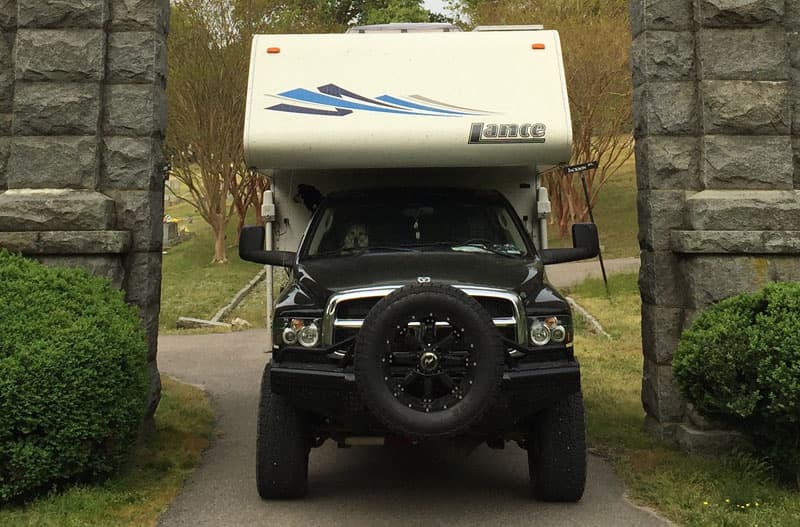
“My spare is mounted on our beefy front bumper. It’s the only place we could figure out where it could go. I had a custom made mount fabricated for the receiver and it bolts to that.
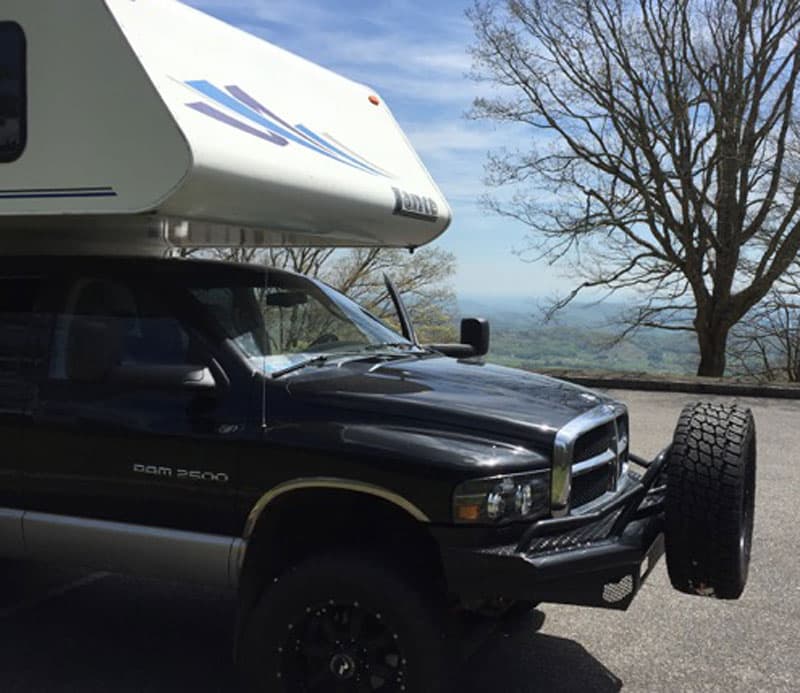
To minimize road vibration, we took a tie-down and snugged down the tire to the bumper. It’s also locked onto the bumper. We have easy to access and I can lift it up and down myself.” – Karen House, 2005 Ram 2500, 2005 Lance 811
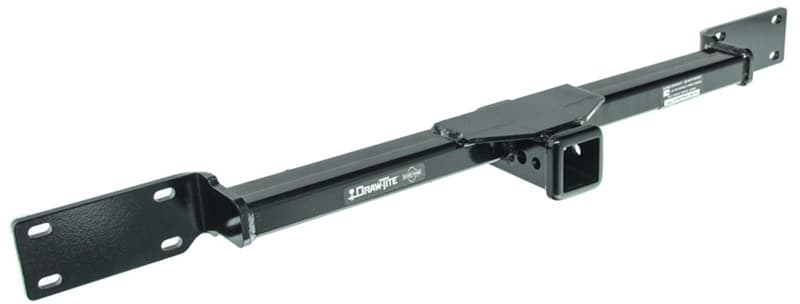
“I am planning to drive from Houston, Texas to Deadhorse, Alaska this summer and I am bringing a second full-size spare. I installed a Draw-Tite front receiver hitch and I am waiting for my Wilco Off-road Hitchgate Solo XL to arrive.
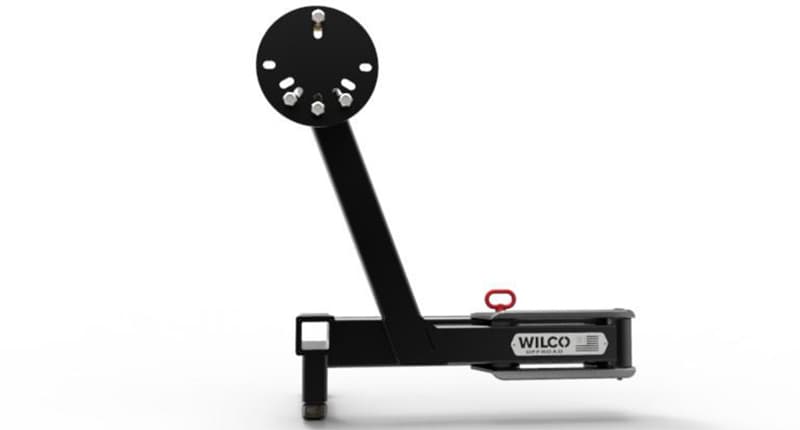
They also have a license plate holder that mounts to the tire carrier to ensure it won’t be obstructed.
Something to note about Wilco Off-Road is that I placed my order March 28 and they estimate that I will receive it May 24. So, plan ahead if you want one.” – Chris T., 2016 Ram 3500, 2017 Northstar Arrow U
“Our plan is to construct a supply trailer, approximately 5’ x 8’ with heavy suspension and wheels and tires to match the Silverado. Two matching wheels and tires will be mounted to the trailer (location TBD).
One of the obvious benefits of the supply trailer is to keep the camper clear as well as contingency planning with wheels, fuel, tools, and beer.” – Dennis Glover, 2016 Silverado 2500, TBD Pop-Up
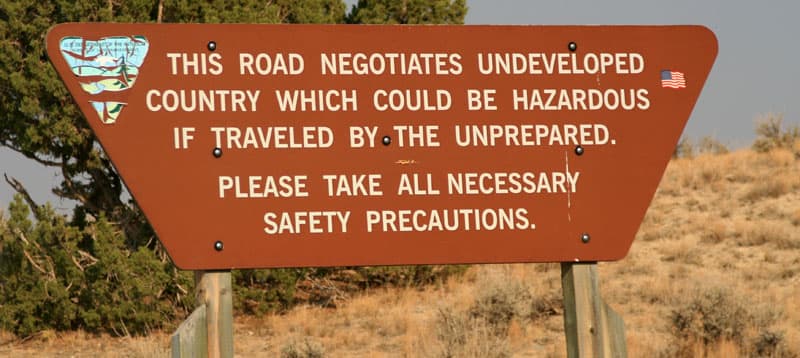
“I had a flat tire with my 2006 Chevy. If I had remembered to put the plug kit in the truck, I would not have had to take the wheel off. I could have fixed it on the truck and aired it up with our 12-volt air pump.
We were on an outback road in Wyoming at the time with no cell service. After removing everything stuffed in the back seat, we got the jack out. I got under the axle before the rear tire went completely flat.
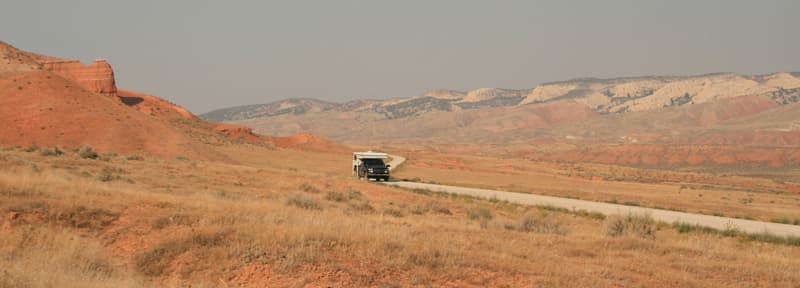
Then it was time to get to the spare tire. Let us save ourselves some trouble and get the manual out. First thing the manual says is, “If the cable is still there…”. Now we know we are in trouble. Shame on GM for a poor design!
The tire would not come down because the secondary lock would not let go. We put the flat tire back on, aired it up, and off we went back to a ranch we passed five miles back. Those ranchers were a God send. They fixed the tire and would not take any money for it.
The next day we stopped at the GM dealer in Cody, Wyoming. The service manager got out his two pound hammer, knocked the dirt out of the secondary lock, and down it came. He said that the same thing had happened to his in-laws that month. If the manual had said, “Hit it with a hammer” I could have done that.
One of these days I am going back to drive that road. I have not yet practiced getting the spare out of the new truck. I will have to move that up on my to do list. Thanks for the reminder! Keep up the good work.” – Matt Reinker, 2016 Ford F150, 2006 NorthStar TC650
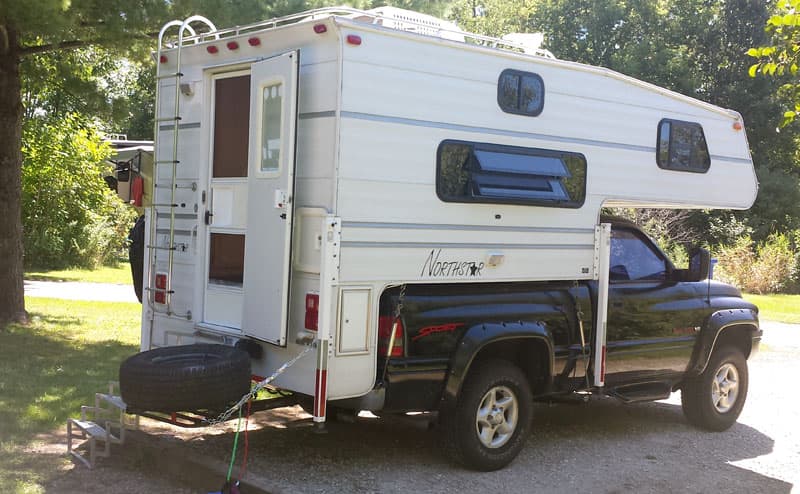
“I made a rack for my spare tire on the back of my camper. I attached it to the hitch.” – Tom Williams, Northstar
“We have replaced the original spare due to the fact that we upped the size of our tires to 265’s from the 245’s that came with the truck.
We keep the spare in the original spot under the truck bed. It is possible to remove and replace the tire while the camper is loaded.
The only time we had to access the spare was to make the change. This occurred during our trip last year while in Napa, California. We had a flat tire at the Napa Valley Fairgrounds RV park, and had two tires replaced. Ugh.” – Barry Schoenwetter, 2006 GMC Sierra 2500HD, 2005 Lance 1030
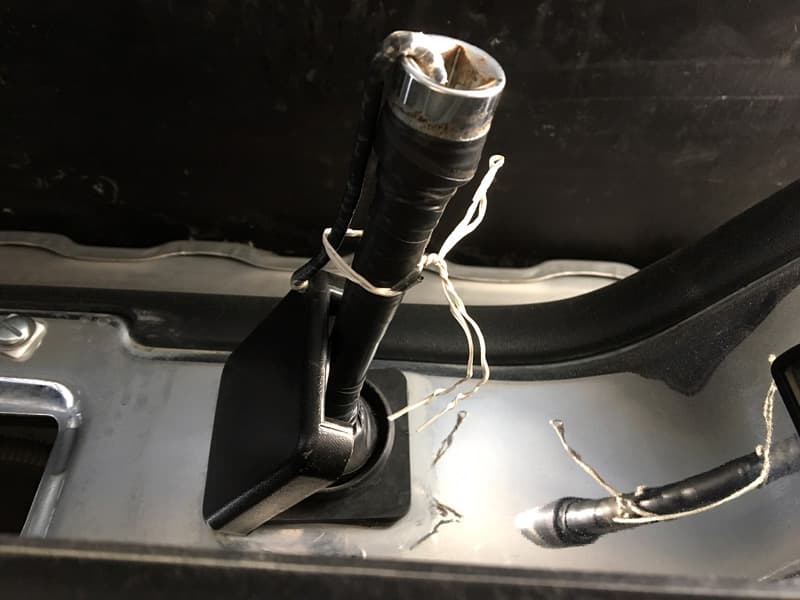
“I have never carried two spares. I used to drive the big diesel pusher motorhomes that do not even come with a spare. I have driven the Alcan Highway 19 times in various rigs and (knock on wood) have never had a flat. If I did, that is what Good Sam road service is for. With OnStar (for remote calling), or a cell phone, you are always in touch these days.
Now that I drive a pickup and camper, I have a spare tire. I did think about access to it with the big overhang of my camper. You could not normally access the spare with the camper on the truck. So, I modified the handle I crank down the spare tire with.
I put two pieces of the handle together. Then, I put it in the hole that you access the gear that lowers the spare. I measured it, and then cut the handle off to where it is just past the bumper of the pickup.
Then, I install a female 1/2-inch socket on that end and put it back in the hole where it is engaged with the gear. I fastened that in so that it will not work its way out during travel.
I have to crawl under the truck to crank it down, but I just carry a 1/2-inch ratchet and it works perfect. This way I can use the original spare tire carrier.” – David Donovan, 2007 Chevy K3500, 2012 Chalet TS116
“I’ve been dropping the spare way too many times lately. I needed the room for installing my AirLift Levelers. Just last week, I dropped it again to have some work done on the trailer hitch.
Other than having to deal with the spare’s excessive weight, getting it on and off is a piece of cake. I can’t use the entire jack (my camper hangs over the back), so I use half of it and a Crescent wrench to drop and lift it into place.
If I ever venture to Alaska (which is on my list), the second spare will fit nicely behind me in the extended cab.” – Patrick Strang, 2011 GMC 3500HD, 2011 Lance 950S
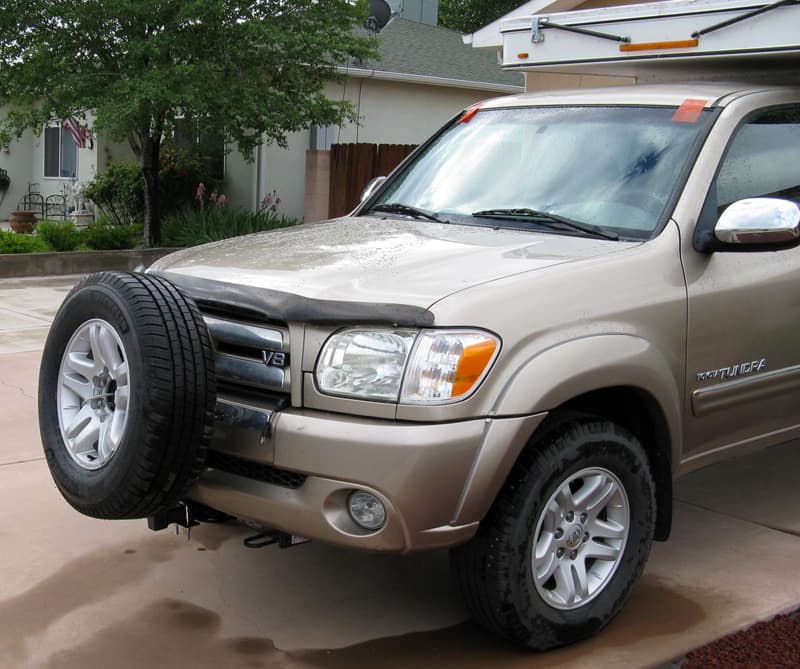
“I put my second spare on a mount in my front receiver hitch prior to my upcoming Alaska, Yukon and British Columbia trip.” – John Pence, 2006 Tundra, 2016 FWC Hawk
“We keep our factory tires in tip top shape, so I only carry one spare. I do carry an updated 12-ton electric jack, 24-inch breaker bar, and an impact socket under the back seat as the factory stuff is useless.
I did get a flat on the rear tire picking up a nail about 60 kilometers from Ignace, Ontario. I dropped the spare, but it was locked by a seized secondary lock mechanism.
Lucky for me, the area I was in was a road construction zone and the crew foreman was good enough to let me borrow his welder to cut the spare free.
This story stretches your question, but it may help other folks from having this problem. I strongly urge that Chevy/GM owners try to release their spares at least once a year, twice in the northern climates where road salt plays havoc with your underbody.” – John Desjardins, 2007 GMC Sierra 2500HD, 2002 Globetrotter
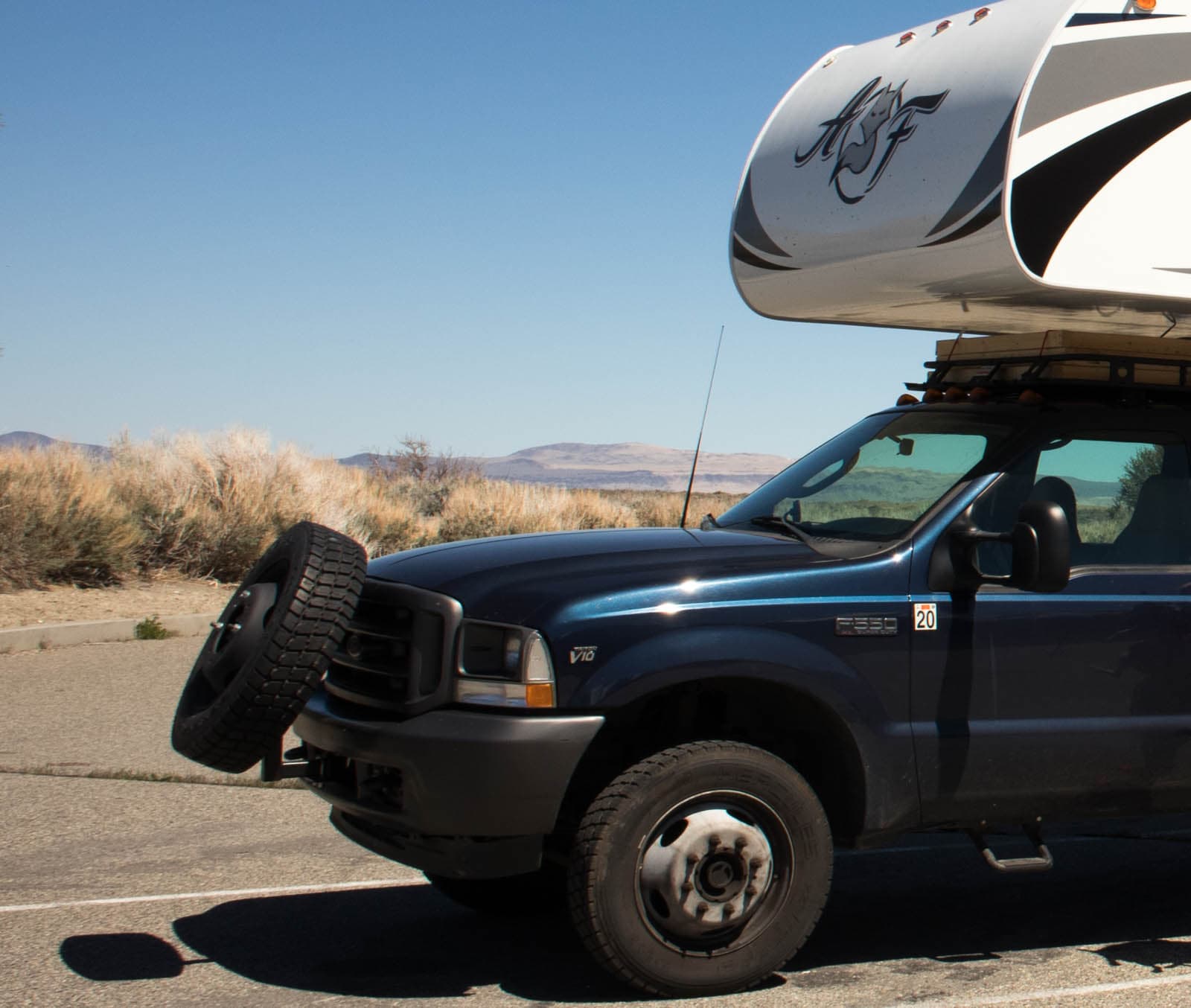
“I have a P225/70R19.5 tire and dually wheel on a Curt front bumper hitch mount. There have been no problems with engine cooling and I have easy access.” – Dan Capshaw, 2003 Ford F550, 2017 Arctic Fox 1140
“Our spare truck tire is located under the truck bed and is raised and lowered by a cable and long crank through the rear bumper. Not wishing to give you a long winded story of my flat tire in a Cheyenne, Wyoming Walmart parking lot, here are the results of my adventure.
1. My spare tire cable lowering mechanism was never cleaned of road dirt nor exercised. The tire would not budge at all. Now I make it a practice to exercise, clean, and grease the cable winch once a year. If your truck happens to be on a rack when you get your truck’s brakes inspected, ask the mechanic do the tire cable also.
2. Carry a tire plug repair kit in your tool kit. We could not get the spare down, so we removed the flat tire, inserted a plug, and re-inflated the tire.
3. Get a jack that will lift the truck and camper at the same time. My original truck’s jack would only lift the truck if it was empty. I now carry a small floor jack and discarded the toy OEM jack.
4. Get a small, but functional air compressor with a long power cord.
Nothing will get you madder than an angry hornet faster than standing in the cold rain and looking at a spare tire that will not budge from the truck bed’s holder, holding a jack that will not lift the truck, and drinking cold coffee.” – Jesse Taylor, 2006 Sierra 2500HD, In between campers right now
“I have four 19.5-inch wheels on the ground. My spare is the standard (for my year, make, and model) 16-inch with a somewhat oversized tire that sits in the standard under bed location.
To access the spare, I loosen the tie-down bolts to raise the camper, fish the tire winch handle into place, and then lower and remove the wheel. Then I jack up the offending corner and replace the flat.
To be honest, I haven’t had to resort to the spare since switching to the 19.5s years ago. I think I’d be able to wedge a deflated one into the spare’s niche but I’m not certain of it. I also have a front mounted receiver hitch, which I can use with a proper carrier if I need two spares, or if the under-bed storage proves unsuitable.
Big wheels and tires are heavy. I’d be interested in learning how other folks manage to manhandle them from storage to axle and back again.” – Mark Obert, 1999 Ford F250SD, 1999 Lance 920
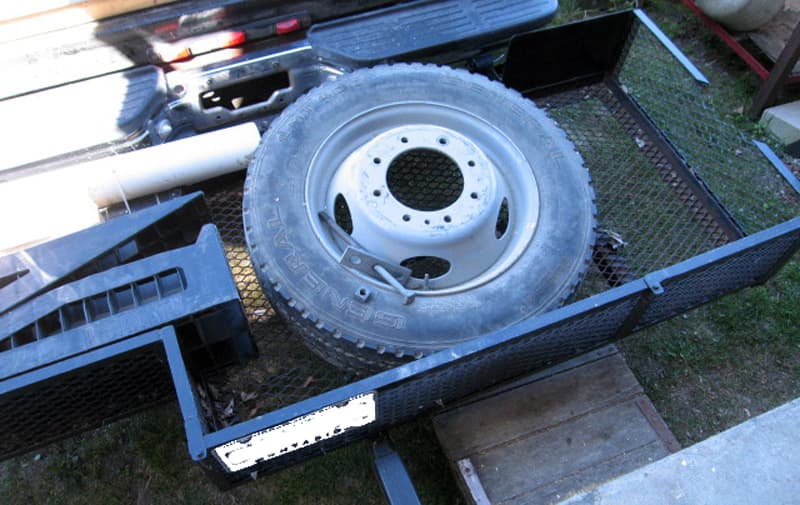
“I have an 8-foot by 4-foot carrier that fits into the rear hitch of the truck. The carrier is under the rear of the camper where I also have my spare, barbecue, leveling planks, and sewage hoses.
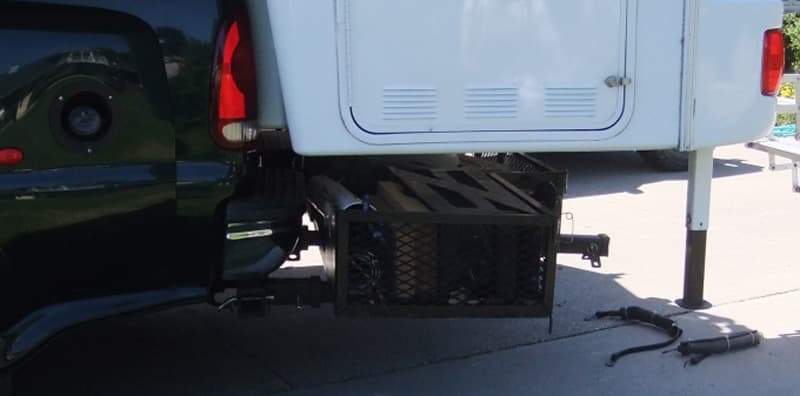
It’s the same size as the back end of the camper. It’s all 1/4-inch steel, so it’s quite heavy.” – Stan Kern, 2002 Ford F450, 2008 Bigfoot c1002
“With a dually, I don’t use oversize tires (look up kissing duals). If I had a single rear wheel, I’d put the spare(s) behind the seat, where my back seat used to be. I carry a generator there now.
With a former pickup, I stored the spare in my truck camper because access under the box was extremely difficult.” – Philip Tron, 2009 Chevy 3500, 2012 Lance 1050
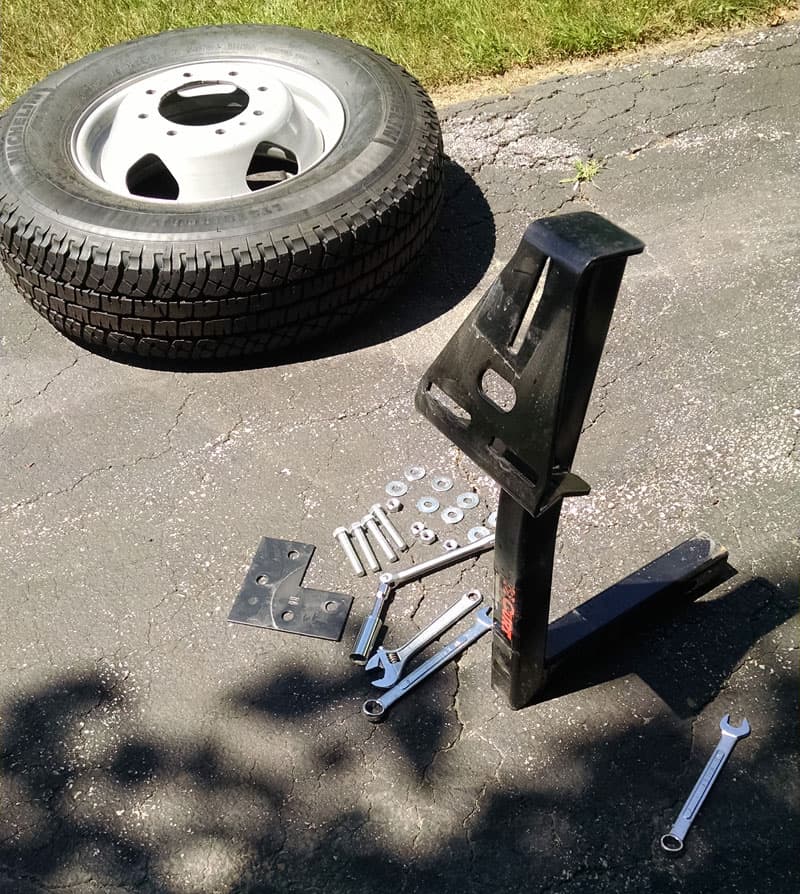
“We took our Arctic Fox 992 from New Jersey to Seward, Alaska – and back – in 2015. We used a 2015 GMC 3500. The weight of the Arctic Fox required a dually.
Six road wheels, the Alcan highway, and the overhang of the camper at the point where the factory spare was located all got me thinking about tires. I had spent four years in a truck company in the Army. My experience was that flat tires tend to occur at inconvenient times, in awkward places, and are accompanied by inclement weather.
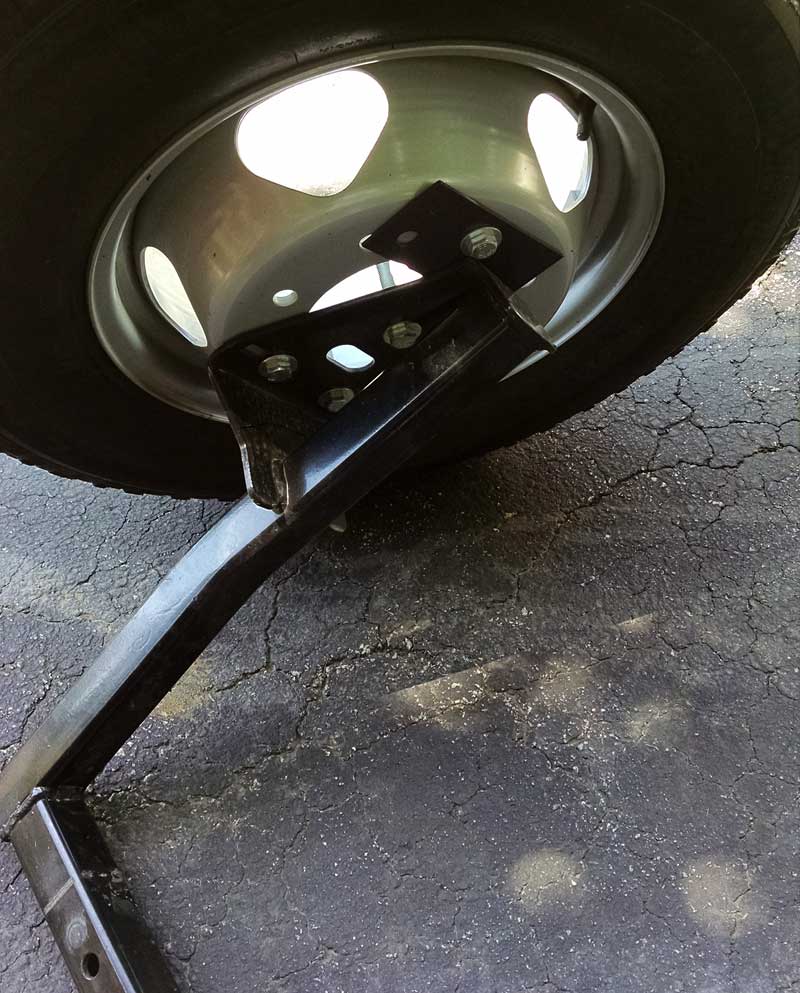
We used the front receiver hitch normally used for a bicycle rack to mount a second spare tire. I got the mount from eTrailer, but had to use a metal plate prefabricated by Stanley to adjust for our wheel size. The good news is that I did not need it.” – Jim Kaley
“My spare tire is mounted under the box of the truck just forward of the trailer hitch.
To make accessing the spare tire easier with the loaded camper, I changed the location of the camper steps. To reach the spare tire access point, I moved the steps slightly off-center to the driver’s side.
I would would also suggest checking the spare tire to make sure it is mounted with the valve stem pointing down so that you can check the pressure on the tire.” – Tom Burns, 2015 Ford F350, 2006 Northern Lite 9-6 SE
“I have a regular-sized spare that is mounted under the bed of the truck. My camper does not extend past the truck bed in the rear, so accessing the spare is no big deal.
Jacking up the truck with the mounted camper is a different story. On a trip through Texas, near Houston on I-10, we blew a tire. It left me with a torn up box and very little space between the ground and my jack point on the truck.
I carry AAA RV coverage, so I called them for help. They initially told me to expect help in 45 minutes. About half an hour later they called back and told us it would be an additional 45 minutes.
In the meantime, a Texas Ranger came along. He helped me change the tire. Between his 3-ton hydraulic jack and my scissor jack we could just barely lift the truck. We did manage to get it high enough to change the tire.
I can not speak highly enough about the professionalism and personal care given us by the Texas Ranger that stopped. He actually got down in the dirt and helped me with the task. I think in the future I’ll cancel my AAA coverage and just make a donation to the Texas Rangers!
As to where I would mount a second spare, I would probably purchase a swing away spare tire holder that would fit my receiver and mount it there or mount it on the front bumper.” – Arn Chamberlain, 2000 Ford F-250, 2004 Palomino Maverick 8801
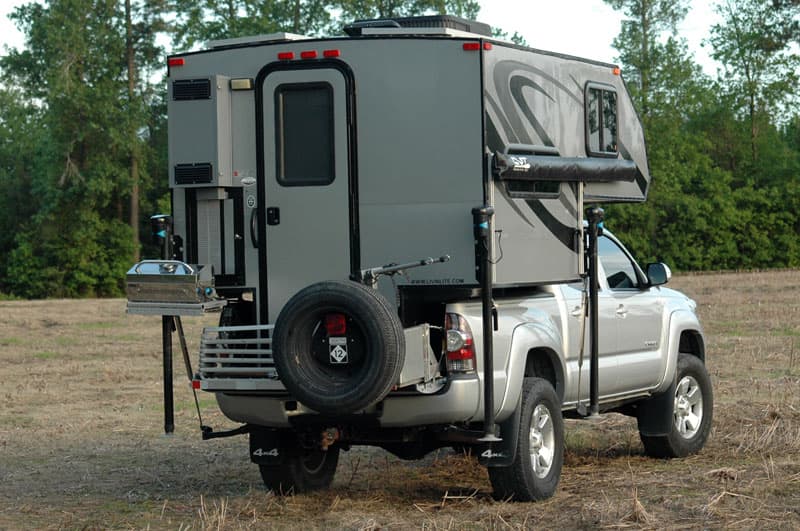
“We have a small rear aluminum porch that has the tire carrier on it. I also added an extra brake and turn signal light inside the tire because the position of the tire blocks the right rear light. The original place for the spare has been used for our auxiliary fuel tank.” – John Hobson, 2013 Toyota Tacoma, 2014 CampLite 5.7
“I went to Alaska in 2015 with a new truck. The tires had about 10,000 miles when I got there and I got two flats in one day. Both happened as soon as I hit the dirt roads.
I was able to repair one as I have a Warn power plant-winch compressor combination and carry an assortment of plugs and patches.
I got to Fairbanks and replaced all six tires with Bridgestone Duravis M700 HD tires. The dealer told me they were the only tires they put on Alaska DOT trucks heading north on the haul roads. I had no further problems.
To answer your question, I only carry one spare but, it is more important to have the right tires for the job.” – Todd Syska, 2014 Ram 3500, 2015 Arctic Fox
“I have a front receiver hitch mounted spare. I removed the spare tire from under the truck’s bed. I never tried to access the spare under the truck but, with the overhang of a large camper, it appears to be difficult.” – Jay Brower, 2017 Ford F450, 2014 Chalet TS116
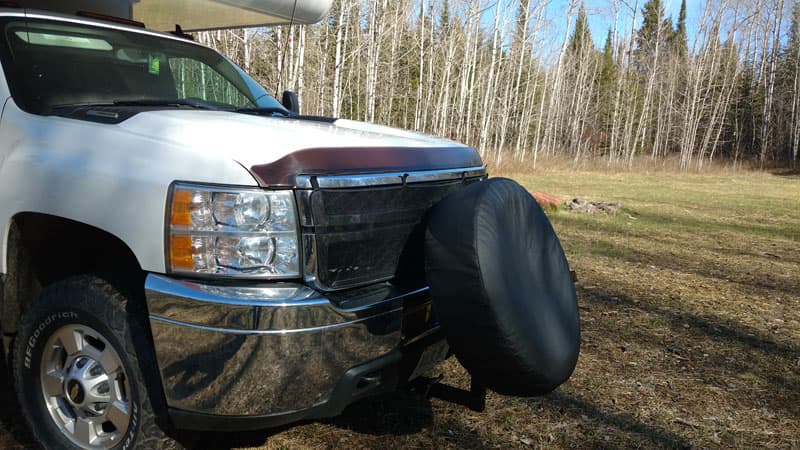
“I installed a front mount trailer hitch on the front of my truck. I had thoughts of trying to access the spare if a rear tire blew. The spare tire carrier slides into the hitch and carries the spare perfectly. I also bought a tire cover to dress it up a bit. If I want to carry a second spare, it would go underneath in the factory carrier.” – Bill Londry, 2016 Adventurer 86FB
“We have replaced the original spare due to the fact that we upped the size of our tires to 265’s from the 245’s that came with the truck.
We keep the spare in the original spot under the truck bed. It is possible to remove and replace the tire while the camper is loaded.
The only time we had to access the spare was to make the change. This occurred during our trip last year while in Napa, California. We had a flat tire at the Napa Valley Fairgrounds RV park, and had two tires replaced. Ugh.” – Barry Schoenwetter, 2006 GMC Sierra 2500HD, 2005 Lance 1030
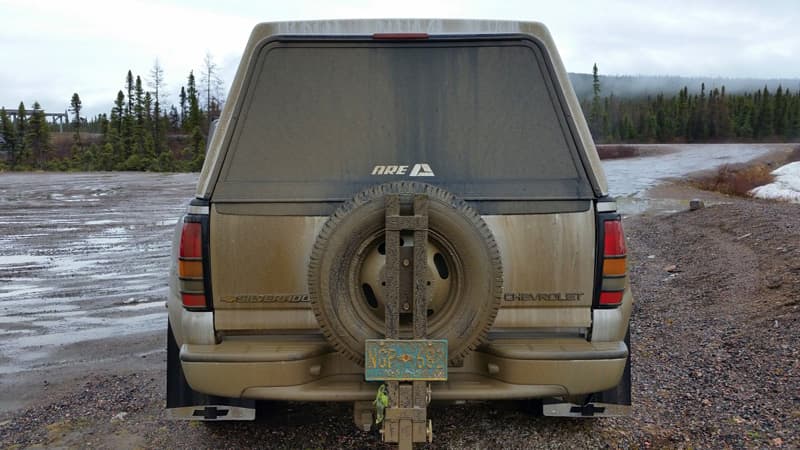
“We have a camper shell with a sleeping platform. Last year we traveled from Maine through the Maritime and Atlantic provinces and then west on the Trans-Labrador Highway. Two spares were recommended. Luckily we didn’t need any.

My husband, Ian, designed and then had welded a special rack for the second spare. We had to drop it to be able to get in and out of the back of the truck, but it only took a few minutes.” – Cathie Leslie, 2004 Chevy Silverado, ARE camper shell
“Our spare is mounted under the truck. We’ve never had to access the tire. If we do, this is what I have set up and believe will work.
1. A heavy duty 12-ton hydraulic jack with an ADJ lift to lift the truck while the camper is on the truck.
2. A socket to fit the tire take-down rod and ratchet. With the ratchet and socket that fits on the end of the rod, you should be able to lower the tire down using half turns with the ratchet. It is easier than pulling the turn handle off each time you turn it.
The original turn bar that goes on the end would be hard to turn with my camper on. My camper overhangs the bumper hole for the rod to go into the spare. This way I can just ratchet the tire down and up. I haven’t had to use it yet, but if I do, this should work.” – Jim Furubotten, 2006 Ford F350, 2014 Northern Lite 10-2 CDSE
“I mount my 19.5-inch spare on the front of my truck using a spare tire carrier and a front-mounted receiver hitch.
I had the same question, or problem, as Janet. Installing a front hitch was the only solution that I could find. The spare is too heavy to mount on the roof and I have a 40-gallon diesel fuel tank under the bed where most spares reside. I have no place to mount a second spare and I hope one is never required.
On the plus side, I can easily access my spare and even re-mount the flat onto the front-mounted carrier. Having the extra weight hanging off the nose of the truck helps counter-balance the rear-biased weight of the camper.” – David Ruble, 2017 Ford F-350, 2017 Phoenix Pop-Up
“One option is to build a frame over the cab and mount a wheel there. A small hand crane will be needed to lift it on and off. This what I will likely have to do. Another alternative is a rear swing frame to swing the wheel out of the way when accessing the camper module.” – Jason Firmstone, Unimog
“We do a lot of boondocking and driving on rocky dirt roads. We don’t carry a second spare because I wouldn’t know where to put it. What we do have is the highest quality load range E, 10 ply, all-terrain tires we can find, including the spare.
In all the years we have been driving these roads, including Alaska, we have never needed a second spare. Twice we have had side walls blow out on very rocky roads. Cranking down the spare from under the pickup bed is not difficult, but you will get dirty. To me, the hard part is getting the flat tire positioned to crank it back up under the pickup bed.
By the way, with the camper mounted, we inflate the rear tires to 80psi. We also keep the spare at 80psi.” – Brian and Chris Hagen, 2004 Dodge Ram 2500, 2014 Palomino SS-1251
“I have a front hitch on my truck and a tire carrier that I use at times for my extra spare. Although I don’t care to have the tire sitting out front from an appearance perspective, it is much easier to get to than when the spare is mounted under the rear of the truck. My tires are the stock size for the truck.” – Gary Hughes, 2005 Chevrolet 3500, 2015 Lance 1172
“My spare is still located under the truck in the factory location. I have the 19.5 conversion. The spare is a 16-inch oversize tire that fits because it’s the same diameter as the 19.5 tires. The problem with having the spare in the factory location is that I need to remove the camper to get to the spare tire.
I run a tire pressure monitoring system to give me as much of a heads up as I can get if a tire is going down. That way I can stop in a suitable place.
I have thought of a second spare. I don’t know if they still make front bumper tire mounts for newer trucks like I used to have on my 1970 Chevy truck.” – Erwin Greven, 2002 Chevrolet 2500HD, 2002 Lance 921
“When I can, I mount my second spare tire on the front of the truck. I do this for very long trips such as our 2012 trip to Alaska. As to the second question about changing a tire without the front mounted spare, we did it once in Canada near Ottawa and it was a pain in the @#&. Thanks for TCM. Keep up the good work.” – William Chiles, 2015 Ram 3500, 2013 Lance 1050S
“We mount our second spare on a Draw Tite bracket that slides into a receiver mount on the front of the truck. Yes, we have accessed it. It’s no problem.
I just unlock the padlock, remove the rubber hose covered security chain, remove the three mounting bolts and take off the tire. Our tires are 16-inch tires, so it’s a bit of a job, but doable. If my tires were larger, I don’t know if I could manage mounting the flat tire back up on the bracket.
We have been asked if we have had any engine cooling problems because the spare is positioned in front of the radiator. There has been no significant increase in indicated engine temperature.
The primary spare is mounted under the truck. We have accessed it. To do so we had to loosen the Torklift Fastgun turnbuckles and raise the camper a bit off the truck. Since the tire we were replacing was a rear tire, raising the camper was essential.
Because of raising the camper, we did not need the jack to handle the weight of both the truck and camper. Of course, one needs to make certain to have blocks/pads for the jack legs and chock blocks for the truck.” – Firman Schiebout, 2004 Ford F350, 2012 Northstar 9.5 Igloo U
“We always carry two spares! One is under the truck as it should be. The other one is covered in a blanket and rides in the back seat on the driver’s side. Before anyone gets worried about about a tire projectile during an accident, it is a well behaved tire and always wears its seat belt.
We did have a flat once and I rolled the back seat tire out and replaced the flat. Then I put the offending tire in, put the seat belt on, and gave it the blanket to console it. Easy-peasy.” – Jerry Bonneau, 1995 Ford F350SD, 2002 Lance 1061
“I bought a receiver specifically made for mounting a spare on the front of the truck. It’s the best move I ever made. You know what I mean if you’ve ever tried to get one of those heavy tires out from under your truck with a camper on and a boat hooked up. There are no heating problems or any others for that matter.” – Tom Glaser, 1999 Ford F350, 2003 Lance 10-10
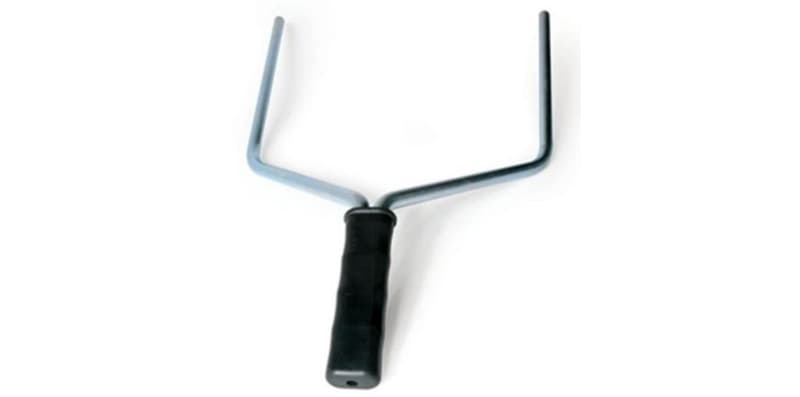
“I found a simple and very easy to use tire lifting tool that really works. I am 72 and have very limited use of my right shoulder. I could not lift the heavy truck tire to place it on the wheel lugs. I found the Camco 44511 Tire Changing Tool on Amazon and have been very pleased in how it works. I have used it to change the wheels on my skid steer loader which weighs over 130 pounds.
To use it you place the tool under the tire. Have the lugs and wheel holes properly oriented and merely lift up on the handle. It takes a bit of practice to get it properly lined up, but it sure works for me. I have several of them and always keep one with my tire changing tools when I travel. Luckily I have never had a flat on the road, but I have used it several times at home to remove/replace the wheels while working on my vehicles.” – Carlton Basmajian
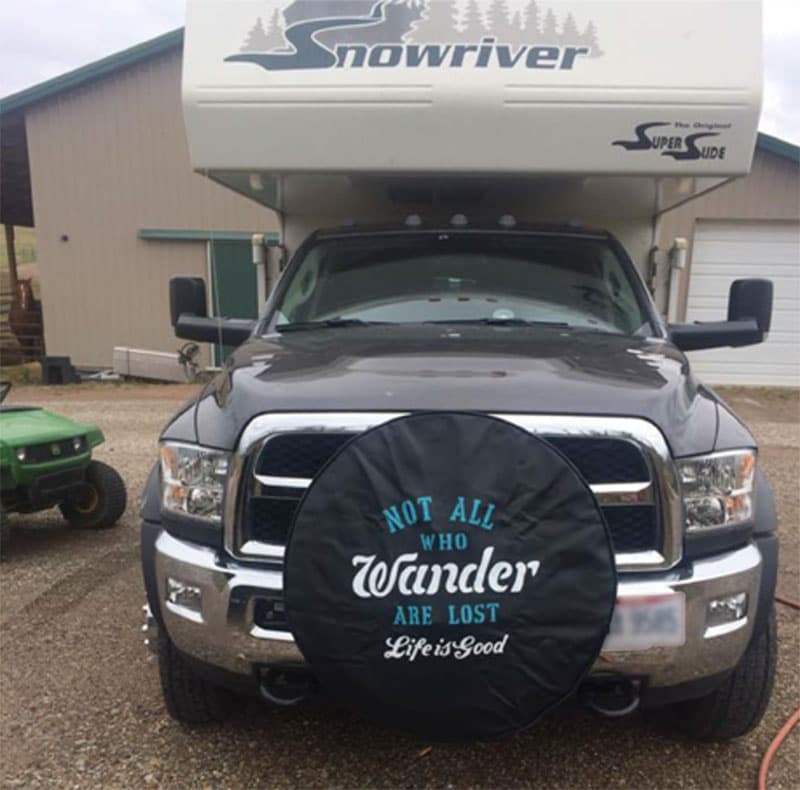
“Finding a place for our spare tire with the truck camper mounted has always been a challenge. Our truck has duel fuel tanks so the spare cannot go underneath the truck.
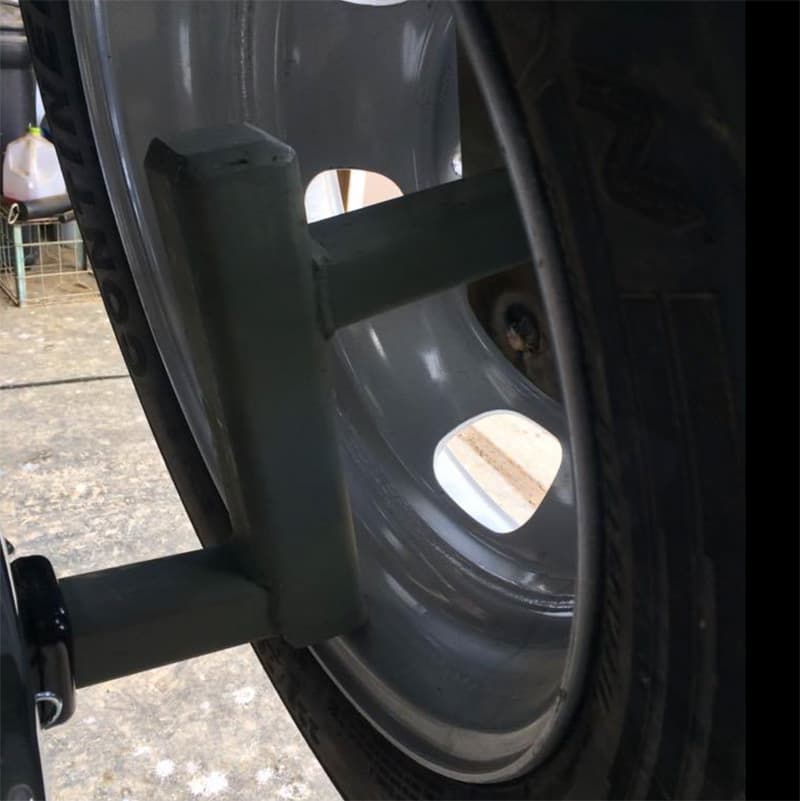
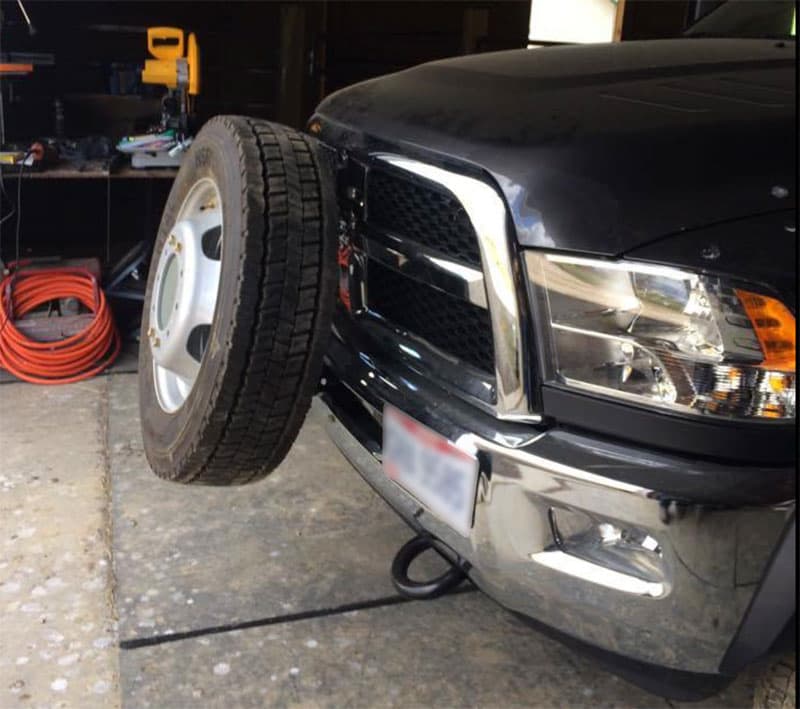
My husband Pete, designed and made this tire carrier. It is attached through a front mount receiver.” – Linda Clark
“Marylou says I keep my oversized spare tire right above my belt. She can be cruel like that.” – John Wells, 2011 Chevy 3500, 2012 Chalet Ascent S100F
























